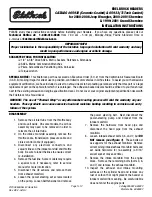
Tires and wheels
241
1
Tire and Loading Information placard with
recommended cold tire inflation
pressures
The Tire and Loading Information placard lists
the recommended cold tire inflation
pressures for maximum loaded vehicle
weight. The tire inflation pressures listed
apply to the tires installed as original
equipment.
Important notes on tire inflation
pressure
G
Warning!
If the tire inflation pressure drops
repeatedly, check the tires for punctures
from foreign objects and/or whether air is
leaking from the valves or from around the
rim.
Tire temperature and tire inflation pressure
are also increased while driving, depending
on the driving speed and the tire load.
If you will be driving your vehicle at high
speeds of 100 mph (160 km/h) or higher,
where it is legal and conditions allow, consult
the tire inflation pressure label on the inside
of the fuel filler flap (if available) on how to
adjust the cold tire inflation pressure. If you
do not adjust the tire inflation pressure,
excessive heat can build up and result in
sudden tire failure.
If your vehicle is not equipped with the tire
inflation pressure label on the inside of the
fuel filler flap, contact an authorized
Mercedes-Benz Center for proper tire
inflation pressure.
i
Driving comfort may be reduced when the
tire inflation pressure is adjusted to the
value for speeds above 100 mph
(160 km/h) as specified on the tire inflation
pressure label located on the inside of the
fuel filler flap.
Make sure to readjust the tire inflation
pressure for normal driving speeds. You
should wait until the tires are cold before
adjusting the tire inflation pressure.
Some vehicles may have supplemental tire
inflation pressure information for vehicle
loads less than the maximum loaded vehicle
condition. If such information is provided, it
can be found on the tire inflation pressure
label located on the inside of the fuel filler
flap.
Tire inflation pressure changes by
approximately 1.5 psi (0.1 bar) per 18‡
(10†) of air temperature change. Keep this
in mind when checking tire inflation pressure
where the temperature is different from the
outside temperature.
Potential problems associated with
underinflated and overinflated tires
Underinflated tires
G
Warning!
Follow recommended tire inflation
pressures.
Do not underinflate tires. Underinflated
tires wear excessively and/or unevenly,
adversely affect handling and fuel
economy, and are more likely to fail from
being overheated.
Operation
Z
Summary of Contents for 2009 CLK-Class
Page 1: ...CLK Operator s Manual...
Page 26: ...24...
Page 28: ...Exterior view 26 Exterior view At a glance...
Page 30: ...Exterior view 28 At a glance...
Page 32: ...Cockpit 30 Cockpit At a glance...
Page 34: ...Instrument cluster 32 Instrument cluster At a glance...
Page 147: ...Audio system 145 Operating and display elements Controls in detail Z...
Page 226: ...224...
Page 276: ...274...
Page 309: ...Vehicle status messages in the multifunction display 307 Practical hints Z...
Page 360: ...358...
Page 384: ...Order no 6515 1338 13 Part no 209 584 44 97 Edition A 2009 2095844497h 2095844497...
















































